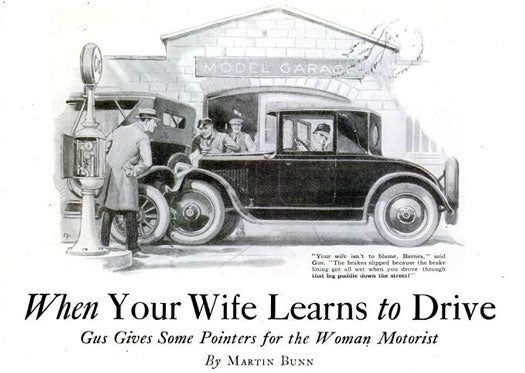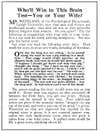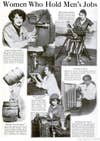Over the years, Popular Science has strived to answer your questions about the world we live in. What’s on the moon? Why don’t we have flying cars? How do magnets work? As compelling and relevant as these questions are, though, none inspires as much fury as the age-old debate on whether men and women are equally capable.
For the most part, we answered no. Like it or not, our magazine has always been a product of its time, and for at least the first 70 years of our 138-year history, we held men in higher esteem because science and feminist literature had not yet given us reason to believe that women could accomplish much on a grand scale.
Click to launch the photo gallery.
While the battle of the sexes began thousands of years ago, we began paying extra attention to it in 1920, when women won the right to vote. Women began to matter, and as a male-dominated publication, we weren’t sure we approved. We balked women female athletes either broke, or came close to breaking records held by men. We scoffed at women who thought they could drive without getting into an accident. “Men, it seems, are able to beat women in sports just because they are men, endowed by nature with superior qualities of speed, strength, and stamina!” we wrote after arguing why women’s sports were a farce.
Still, we couldn’t deny the psychology reports demonstrating that male and female students scored equally on intelligence tests. We couldn’t deny that the male and female brains donated to science bore the same weight and measurements. A few of our writers conceded, saying that men and women were separate but equal. Their intelligence and temperaments complemented each other.
But this is the pre-Betty Friedan era we’re talking about. Calling women equals in the mid-1920s might have been a step forward, but later that decade, we took two steps back after publishing Dr. Prescott Lecky’s article on why women can never achieve greatness.
“Women do not count large among the geniuses because they do not want to be geniuses,” he wrote. “They want to be women.”
Offended? Amused? Or (lord help you) inspired? Click through our gallery to read more about the early 20th century’s attitude toward female intelligence, athletic ability and driving skills.
The Rise of Female Athletes: March 1923
When 18 year-old Sybil Bauer became the first woman to break a man’s swimming record, she inspired scores of female athletes to further challenge the dominance of men in athletics. Ethelda Bleibtrey, American Olympic gold medal winner turned swimming coach, was so certain that women would one day reign supreme in sports, that she began grooming her own class of “super-swimmers” toward breaking more records. Here, she describes how women were steadily improving at golf, tennis, hockey, soccer and ice skating. She also noted that to compensate for their small body size, female basketball players relied on their natural teamwork skills and agility to beat men at the game. Sybil Bauer was no anomaly, either. Schoolgirls could run the 100 yard dash in 12 seconds, while boys of that age could run it in only 10 and a half. Rhea Riedel could throw a javelin 98 feet, and Eleanor Churchill could throw a baseball 224 feet, which wasn’t far behind the 290 feet record held by a man at that point. “I predict that Miss Bauer’s swimming record definitely marks the beginning of an era when the world’s sports crowns will fall, one by one, before the conquests of the ‘weaker sex,'” Bleibtrey wrote. “And that eventually women will wear as many of these prizes as men.” Read the full story in “WIll Women Athletes Win Men’s Crowns?”
Is Your Wife Smarter Than You?: November 1924
Despite winning the right to vote in 1920, and despite research demonstrating that men and women scored equally on skills tests, women continued to face discrimination. While we acknowledged that women were as smart as men, we insisted that the genders were complementary, and not quite comparable. Famed American psychologist Edward Lee Thorndike said that women surpass men in “spelling, English, foreign languages, immediate memory and retentiveness.” Men, on the other hand, excel in history, physics, chemistry, “ingenuity,” and physical coordination. Not to mention that women have a deeper understanding of human nature. Thorndike said that while women are intrigued by personalities, men are more interested in the facts. At the theater, a woman would overlook a skilled performer if he played the villain, but would love a mediocre, yet handsome actor as the lead, presumably because she loves the personality of a dashing hero. When it comes to elections, men would examine a candidate’s accomplishments while a woman would scrutinize his family life and church attendance. All in all, we concluded, men and women were “equals and complements,” but in society, men simply held more power. Not only did they have more opportunities, but they possessed a wider spectrum of intelligence than women. “The Caesars, Napoleons, Lloyd Georges and Edisons probably always will be men–but likewise the biggest fools probably will be men as well.” Read the full story in “Are Women as Smart as Men?”
Whose Brains are Bigger?: Dec 1925
Helen Hamilton Gardener, a prominent American suffragist, fought brilliantly for equal rights up until her death in 1925. After opening her will, attorneys discovered that she’d donated her brain to science – specifically, to Cornell University so that they could study her brain. Maybe then, researchers could settle the old question of how head size reflected intelligence, and whether women’s brains were physiologically comparable to men’s. By this time, judging people by the size of their hats (bigger hats equal bigger heads, which equal bigger brains) had largely gone out of style, but a little scientific study couldn’t hurt. Cornell researchers found that Gardener’s brain weighed exactly the same as that of the late Dr. Burt Wilder, a respected Cornell faculty member. Gardener’s insistence that women are as intelligent as men was also supported by the research of psychologists who administered IQ tests on male and female students. For high school and university students nationwide, the results were about the same. Another psychologist at Columbia University tested the intelligence of several male and female fraternal twins and found the sexes to be equal. At the same time, nearly all of the test reports showed that the highest and lowest scores were made by men. Although there were more exceptionally intelligent men than women, there were also more men who underperformed. Read the full story in “Why You May Wear a Small Hat and Still Have a Big Mind”
Woman Workers: March 1926
Who says a woman can’t weld metal, handle heavy labor, or repair vehicles? In this spread, we profiled several women who held traditionally male jobs. Martha Hoffman Henke was so good at welding, that she was able to demonstrate her skills to the American Welding Society and to the Massachusetts Institute of Technology. Helen Antonkova, a Siberian student of mining engineering at the University of Washington, could easily overhaul a mining drill. An Englishwoman known only as Mrs. Park of Garrard’s Cross invented a portable telescopic nursery gate, which kept babies from wandering into dangerous areas of the home. The list goes on, so read the full story in “Women Who Hold Men’s Jobs”
Why Men Beat Women at Sports: November 1926
The athletics debate continued with the occasional record broken by woman golfers, tennis players and swimmers. What was happening? Were women evolving? Or were they simply being given more opportunities to practice and play? We noted that during the Jazz Age, women shed their constrictive garments for lighter, shorter clothing, which let them run about on the courts more freely. Despite their progress, women lagged far behind men in athletics, and we were certain they’d never catch up. Not only were they physically incapable of besting a man’s record, but their style was inferior as well. In golf, for example, most women failed to hit their approach shots as confidently as men did. Not only that, but good men golfers beat good women golfers because they had better timing and were stronger. “Golf is a game that demands many decisions which when once made must be acted on with confidence,” we said. “Women never have been remarkable for the ability to make up their minds quickly, and to keep them made up.” Elsewhere, such as in tennis, men demonstrated greater endurance, speed, hitting power and tactical ability than women. “Women’s tennis has been much overrated,” we said. “Action pictures of woman stars in play give the impression that their game is as fast as the men’s game. It isn’t anything like as fast.” Read the full story in “Why Men Beat Women at Sports”
When Your Wife Learns to Drive: April 1927
Between 1925 and 1970, we ran the Model Garage series, which featured a fictional, advice-dispensing veteran mechanic named Gus. In April 1927, Gus gave some pointers to married couples who were tired of fighting over the wife’s supposedly poor driving. “It’s always bad dope for a man to try to teach his own wife how to drive,” Gus said. “No wife likes to play the dumb-bell before her husband, so she won’t admit she doesn’t understand everything he tells her the first time.” He recommended that husbands find a driving coach for their wives to help her learn more effectively. Plus, women faced a physical disadvantage when learning to drive — remember, this was before automatic gears came along — and Gus noted that in the beginning, the physical exertion would stress her nerves. “A woman, being kind of high strung, gets to the point of nervous exhaustion pretty quick,” he said. To prevent accidents, women should refrain from driving so much when she first starts out. Read the full story in “When Your Wife Learns to Drive”
Why Men are Smarter: July 1928
In the summer of 1928, we ran another take on the question of whether the sexes possess equal intelligence. While our previous article was open to the idea that women were different, but equal to men, psychologist Prescott Lecky challenged this idea, claiming that the brain-weighing experiments proved nothing about what the brains of men and women could actually do. He informs us of a news story proclaiming the discovery of a skull with a record-breaking brain cavity. While reading that story, he came across a scientific study of a brain much smaller than average. “Who, do you suppose, had possessed the giant brain?” Lecky said. “A superstitious, ignorant savage, living in the heart of Africa! And the little subnormal brain had been the mental storehouse of the great writer, Anatole France!” Since brain size was clearly irrelevant, the best way to settle the argument was by comparing female accomplishments to male ones. As this spread shows, women have one genius, Madame Curie, but men have 31 presidents, scientists and writers. As far as the “complementary but equal” theory goes, Lecky tore that apart by stating that a woman’s unique skill set isn’t as challenging or practical as a man’s. Women might excel at English and spelling, but those things are much easier than chemistry or physics. She learns easily, but she never asks why or comes up with her own ideas. Meanwhile, male students never hesitate to scheme and figure things out. “He is far superior in ingenuity, in devising ways to do new things,” Lecky said. “He is more the creative thinker.” While women are busy taking orders, men are inventing the steam engine, automobile, airplane and radio. Read the full story in “An Answer to the Age-Old Question: Are Women as Smart as Men?”
Why a Wife Says “No”: August 1956
Forget cars and the classroom — what better setting is there to observe the battle of the sexes than in the home? While discussing how male and female brain physiology affects marital chemistry, we examined sex as a hotbed for miscommunication. Why do women turn down their husbands’ advances? Simple answer: they’re can’t get turned on as easily. Men’s brains are wired to feel aroused when thinking of their wives undressing, “but the sight of him getting undressed or taking a shower is more likely to arouse his wife’s sense of humor.” We suggested that men keep in mind that women need security, emotional fulfillment and to feel loved in order to have good sex. Plenty of women struggle with feeling “depraved” from enjoying sex, so husbands need to reassure them that it’s okay to have a good time. Read the full story in “Why a Wife Says ‘No'”
Advice From a Woman Driver: July 1959
Mary Hauser, winner of Class B in the 1959 Mobilgas Economy Run, scoffed at men who thought that women were inherently bad at driving. “Driving stupidly isn’t a matter of sex but of attitude,” she said, before launching into her tips for “economical driving.”. First, be alert. The less often you erratically hit the breaks, the more gas you’ll save. Anticipate light changes, avoid intersections where you’ll have to stop often, and pass another car only if you have lots of room. Drive at a consistent speed. The best way to save gas while ascending a hill, is by driving up at 45 m.p.h. and holding the accelerator steadily until you hit the top of the rise. People might not take her advice seriously since she’s a woman, Hauser said, but men aren’t perfect drivers either. Most of them are “victims of too much technical theory,” as in, they refuse to open windows for fear of encountering wind resistance. Men also hesitate to use heat during winter because they’d rather go cold and conserve the gas than drive comfortably. Hauser said that in a blizzard, she kept the heat on and would avoid slush by starting the wipers whenever another car drove by. The men she was driving with, on the other hand, had to stop their cars several times to scrape off the slush. Starting and stopping their cars actually used up more gas mileage than they’d anticipated, so they might as well have turned up the heat and used wipers, like she did. Read the full story in “Woman Driver Tells How to Save Gas'”
A Woman’s Mind: February 1952
This feature’s a bit of a bonus, since it doesn’t directly address male-female relations, but we couldn’t help including it. Such passive-aggressiveness, and indeed, a product of its time. After World War II, thousands of families migrated to the suburbs. The structure of houses changed, and people were more open to experimenting with home decor. This house design featured rooms that could be rearranged. Doors and windows could be moved around, rooms could expand, and the walls slid about like panels. Read the full story in “This House Is Changeable as a Woman’s Mind”










